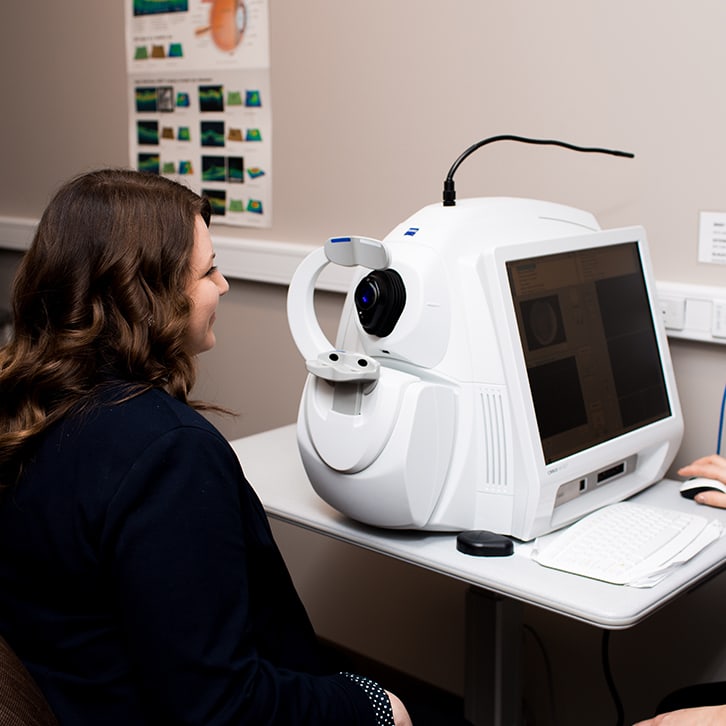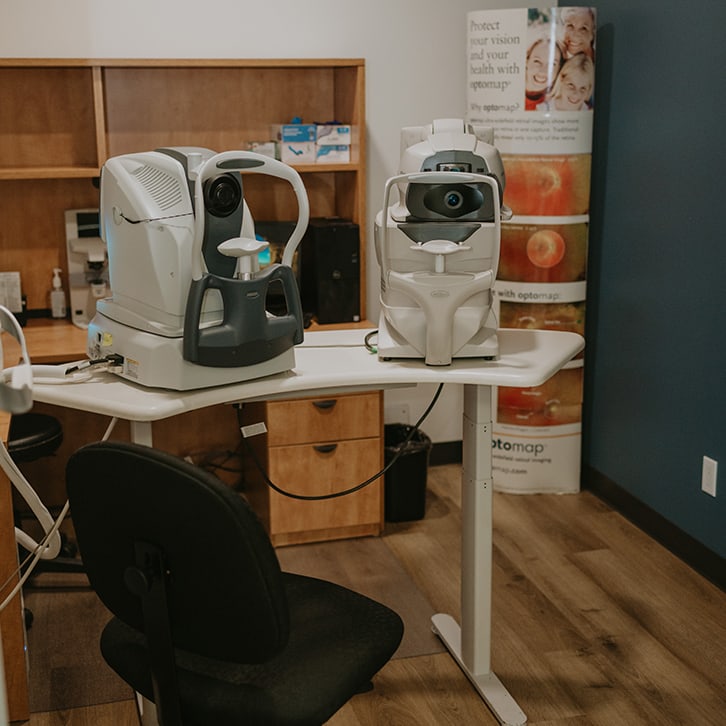Getting Relief from Digital Eye Strain
We know that you can spend countless hours daily using your digital devices—whether they’re computers, smartphones, tablets, or TVs.
Our digital devices have become essential in both work and play, but prolonged use can lead to digital eye strain, a series of uncomfortable symptoms that disrupt your day. The good news? Digital eye strain is temporary and doesn’t cause long-term damage to your vision. However, its symptoms can resemble those of more serious eye conditions.
Our team is here to help you rule out any underlying issues and find relief through a comprehensive eye exam. Contact us to schedule your appointment today.
Recognizing Digital Eye Strain
Digital eye strain occurs when your eyes are overworked from extended screen use. Symptoms can include:
- Difficulty concentrating
- Blurred or double vision
- Sore or tired eyes
- Excessive tearing
- Light sensitivity
- Dry eyes
- Headaches
- Neck, back, or shoulder pain
What Causes Digital Eye Strain?
It’s not the devices themselves but how we interact with them that often leads to discomfort. Eye strain can occur during any visually demanding task—like reading or driving—but it’s especially common with prolonged digital device use.
Factors that can increase the risk of digital eye strain include:
- Uncorrected vision issues like nearsightedness or farsightedness
- Blinking less while focused on screens, which causes dry eyes
- Poor posture or awkward screen angles can lead to neck, back, and shoulder pain
- Glare, reflections, or dirt on screens
- Inadequate screen contrast or brightness
Tips to Prevent Digital Eye Strain
Maintaining good habits can make a big difference. Try these tips to protect your eyes:
- Follow the 20-20-20 rule. Every 20 minutes, look at something 20 feet away for at least 20 seconds.
- Use artificial tears to keep your eyes hydrated.
- Adjust your screen’s brightness and contrast to match your environment.
- Minimize glare by positioning your screen away from windows or bright lights, or use a screen filter.
- Ensure your workspace is set up ergonomically, with your screen at eye level and your chair supporting good posture.
- Update your glasses prescription or consider computer glasses to reduce strain.

Children & Digital Eye Strain
With virtual learning and increased screen time, digital eye strain in children is more common than ever. Because vision is crucial for their development, protecting your child’s eyes helps them grow and learn.
- Symptoms in children can include:
- Neck and shoulder pain
- Eye fatigue
- Blurred vision
- Dry eyes
- Headaches
How Parents Can Help
Children may not recognize the impact of screen use on their eyes, but you can help set healthy habits:
- Encourage frequent breaks
- Limit screens before bedtime
- Promote physical activity
- Position screens properly. Use the 1/2/10 rule—1 foot for phones, 2 feet for desktops or laptops, and 10 feet for TVs.
- Optimize lighting and reduce glare by positioning screens away from bright lights and matching screen brightness to room lighting.
Schedule regular eye exams. Children’s eyes grow and change quickly. Routine checkups ensure their vision stays healthy and comfortable.

Take the First Step Toward Comfortable Vision
Digital eye strain doesn’t have to disrupt your day. Whether you’re navigating work, school, or leisure, our team at Prairie Vision is here to help you and your family enjoy clear, comfortable sight.
Schedule an appointment at our Wainwright or Vermilion locations today to explore solutions tailored to your lifestyle.
Explore Our Services
Protecting Your Vision
Your eyes are your windows to the world and should be nurtured regardless of your age or physical health. A comprehensive eye exam allows our team to detect, manage, and treat eye issues among children and adults.
From early detection of vision problems in children to managing age-related eye conditions in seniors, our experienced eye doctors provide personalized care for every patient.
Your eye health is our priority, and we are committed to delivering the care you need when you need it most. Trust Prairie Vision to be your partner in eye health for life!
Come Visit Our Locations

Wainwright
We serve clients of all ages from Wainwright, Viking, Vermilion, Provost, Lloydminster (Alberta), Macklin (Saskatchewan), and the surrounding areas.
- 2802 15th Ave, Unit 2
- Wainwright, AB T9W 0A4
- Phone: 587-606-0270
- Fax: 780-842-3443
- Email: [email protected]
Hours Of Operation

Vermilion
We serve clients of all ages from Wainwright, Viking, Vermilion, Provost, Lloydminster (Alberta), Macklin (Saskatchewan), and the surrounding areas.
- 5010 50 Street
- Vermilion, AB T9X 1M5
- Phone: 587-606-0394
- Fax: 780-853-6504
- Email: [email protected]
Hours Of Operation
A Variety of Brands Available to You
- Guess
- Lafont
- Michael Kors
- MODO
- Silhouette
- Ray-Ban
- Ted Baker
- Maui Jim
- Alfred Sung
- Eco
- EasyClip
- Evatik
- FYSH
- Nicole Miller
- Nike
- Guess
- Lafont
- Michael Kors
- MODO
- Silhouette
- Ray-Ban
- Ted Baker
- Maui Jim
- Alfred Sung
- Eco
- EasyClip
- Evatik
- FYSH
- Nicole Miller
- Nike







Check Out Our Google Reviews
Wainwright
Vermilion
Blog
Can Dry Eye Cause Floaters?
Dry Eye, Eye HealthThe reality is that dry eye itself doesn’t directly cause floaters. Nonetheless, the 2 conditions can sometimes be interconnected due to underlying factors within the eye. […]
What Is IPL Eye Treatment for Dry Eyes?
Dry EyeIntense pulsed light (IPL) treatment for dry eyes is a noninvasive therapy that uses light energy to help reduce inflammation, restore oil gland function, and improve tear quality.
IPL can offer longer-lasting relief by targeting a common root cause of symptoms, meibomian gland dysfunction (MGD).
[…]
Why Does My Eyelid Hurt When I Blink?
Dry Eye, Eye HealthPlenty of common reasons for eyelid discomfort include eye strain, dryness, allergies, pink eye, and styes. Understanding the underlying differences in these causes can help you take steps to finding relief and recognize when to see an optometrist. […]
Can Myopia Be Reversed?
Children’s Eye Exams, Eye Health, Myopia, Refractive ErrosMyopia, often referred to as nearsightedness, is one of the most common refractive errors in the world today. It’s caused by an abnormal development in […]
Can Dry Eye Cause Floaters?

The reality is that dry eye itself doesn’t directly cause floaters. Nonetheless, the 2 conditions can sometimes be interconnected due to underlying factors within the eye. […]
What Is IPL Eye Treatment for Dry Eyes?

Intense pulsed light (IPL) treatment for dry eyes is a noninvasive therapy that uses light energy to help reduce inflammation, restore oil gland function, and improve tear quality.
IPL can offer longer-lasting relief by targeting a common root cause of symptoms, meibomian gland dysfunction (MGD).
[…]
Why Does My Eyelid Hurt When I Blink?

Plenty of common reasons for eyelid discomfort include eye strain, dryness, allergies, pink eye, and styes. Understanding the underlying differences in these causes can help you take steps to finding relief and recognize when to see an optometrist. […]
Can Myopia Be Reversed?

Myopia, often referred to as nearsightedness, is one of the most common refractive errors in the world today. It’s caused by an abnormal development in […]








